Tesla Model S Plaid Road Test Review: The new American muscle sedan

Short of being a fighter jet pilot, an astronaut or a race car driver, it’s unlikely that you’ve experienced acceleration at the same level as the Tesla Model S Plaid. It’s dumbfounding. Mind-altering. Verging on uncomfortable. The speed at which nature passes you by through the windshield and the side windows is akin to pushing high triple digits in an old “Need for Speed” video game, watching the world bend and stretch around you in that game-ish way. It’s difficult to comprehend without being in the car and feeling it. We knew it was going to be ridiculous, but it still managed to catch us — journalists who drive quick cars all the damn time — completely off guard. There’s no denying it. The Model S Plaid is a special car, and its rapidity is guaranteed to shock you.
That acceleration is but one part of this big sedan’s stat sheet. The Model S Plaid has been on sale for a little more than a year, though we haven’t been able to get our hands on it until now. Since Tesla doesn’t provide test cars for review, we got this one through Turo (more on that experience soon). It’s the one and only Plaid available for rent in Michigan, so we snagged it for one day, which allowed us a maximum of 100 miles of driving. Despite the low mileage limit, we spent the entire day tinkering about, getting familiar with and learning everything we could about what it’s like to drive and operate a Model S Plaid. Just like getting a new phone, though, diving into the interior of a Tesla requires an acclimation period.
The new and weird hits right away with the yoke of a steering device. Our quick take? The yoke ain’t it. There’s only one thing it does better than a steering wheel, and that is to provide a superior, wide and flat resting place for your hands on long highway journeys. Beyond that, the yoke is inferior to a traditional steering wheel in every practical way.
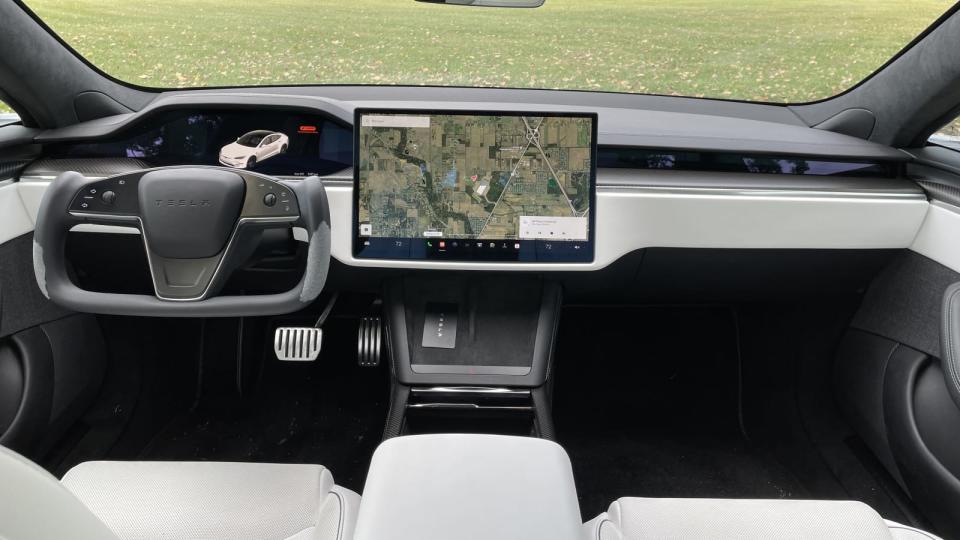
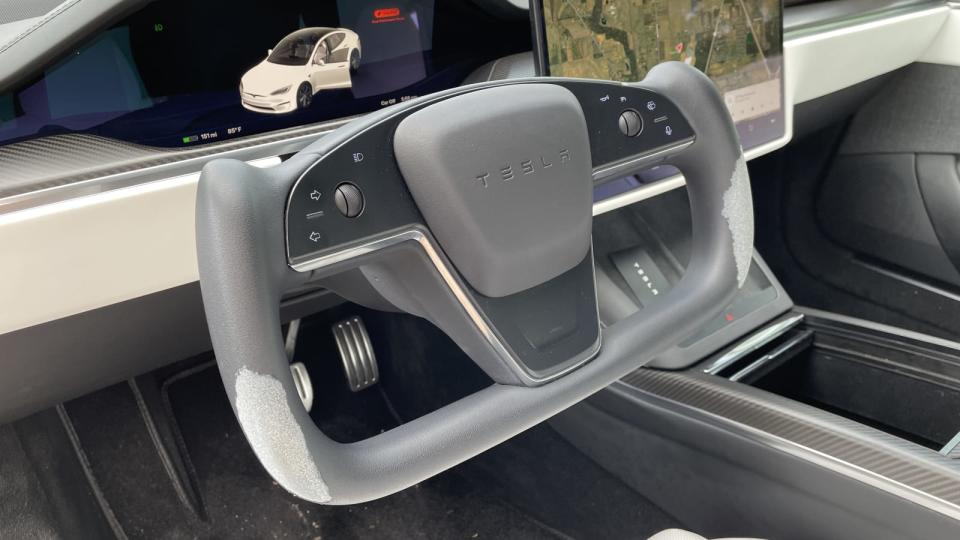
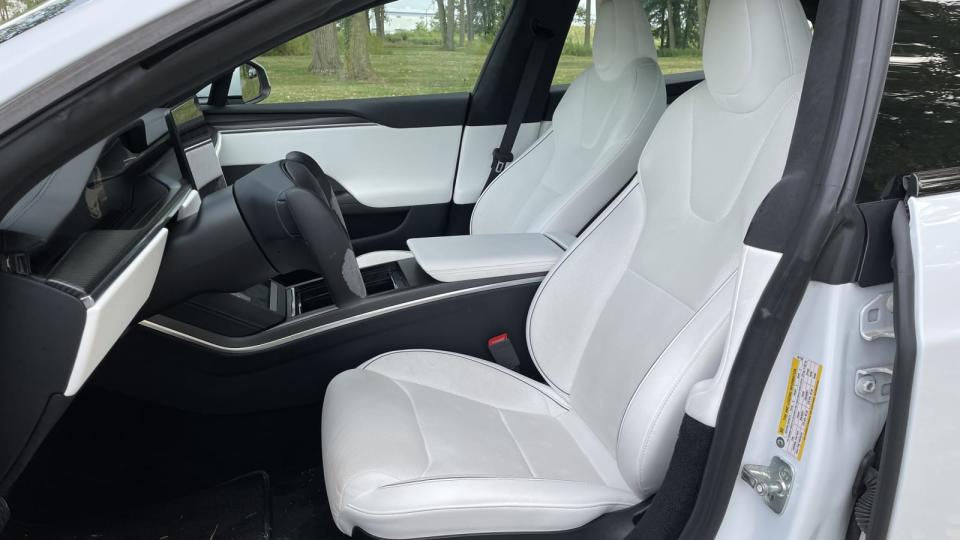
If a turn is 90 degrees or sharper, making said corner is just plain awkward. Want to execute a quick turnaround maneuver? Instead of a convenient rim to grab and keep turning, you’ll find open air. And don’t even start to think that you’ll “adapt to it,” or “get used to it.” Given more time to really get the hang of operating the yoke, it would still be annoying and undeniably worse than a wheel when you need to go lock-to-lock. Even when you’re arcing the Model S through wide sweepers at speed and testing the handling, it is disconcerting. It’s never possible to adjust your grip upward or move your hand around the steering wheel from corner to corner, as one might want to do on a meandering road with slow and fast corners of differing radii. If you do shift position, that one hand loses contact entirely. We found ourselves gripping the yoke tighter and with a greater sense of self-preservation — a nagging fear that it’d whisk out of our grip never went away — than we ever have with a steering wheel.
Also worth noting: The yoke’s covering was largely worn off on our 19,000-mile Model S tester. And sure, perhaps that’s due to heavy hand sanitizer/Clorox use throughout this rental’s life in a pandemic, but it was a sad sight to see after just a year of use. We’ve rented other cars in the past year-plus with similar mileage that didn’t look anywhere close to this bad.
As for the digitized Ferrari-like turn indicators on the steering wheel, those worked better than expected. The Model S is smart enough to realize when you’ve put the indicator on in a merging situation versus signaling for a turn at a traffic signal. Without fail, the car would automatically turn off the signal right after completing a lane change, so a duplicate press was never necessary. Operating the windshield wipers in a similar manner — no stalk — wasn’t problematic either, mostly because you can just set the wipers to auto, and they’ll smartly do their thing. The touchscreen shifter worked well enough, but the “auto shifting” feature where the car is just meant to magically know which direction you want to head did not. We resorted to manually swapping between drive and reverse most of the time. And don’t worry, we tried out the silly sound effect “Boom Box” horn, too. Senior Editor James Riswick is right. It’s a public nuisance.
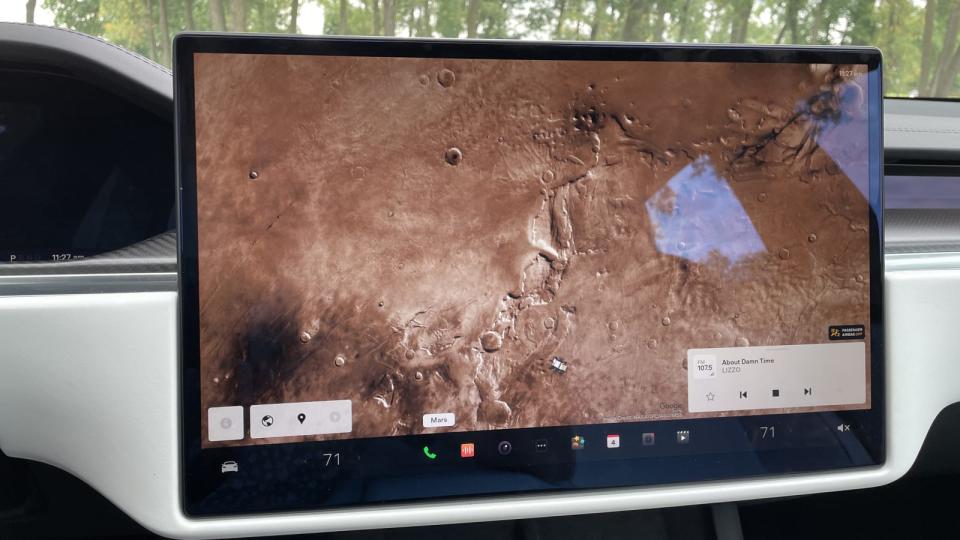
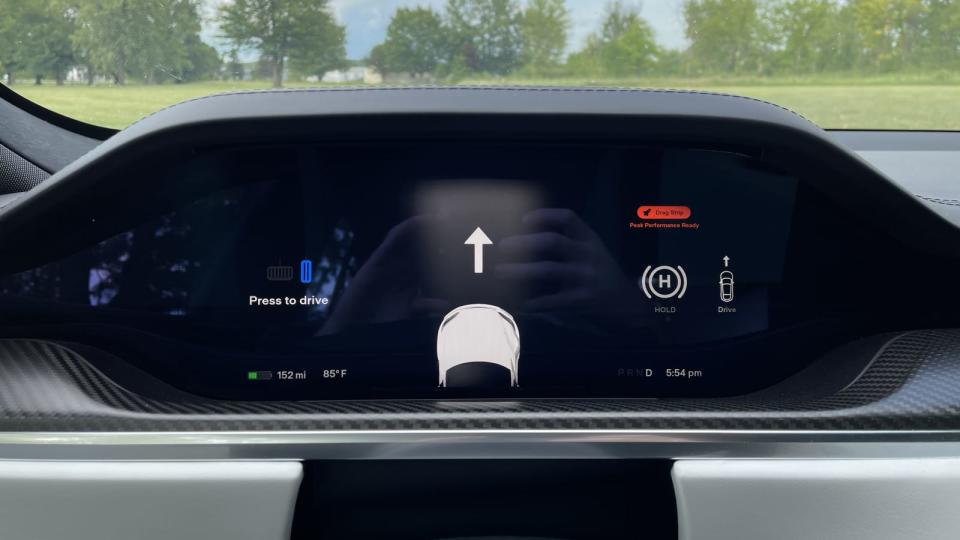

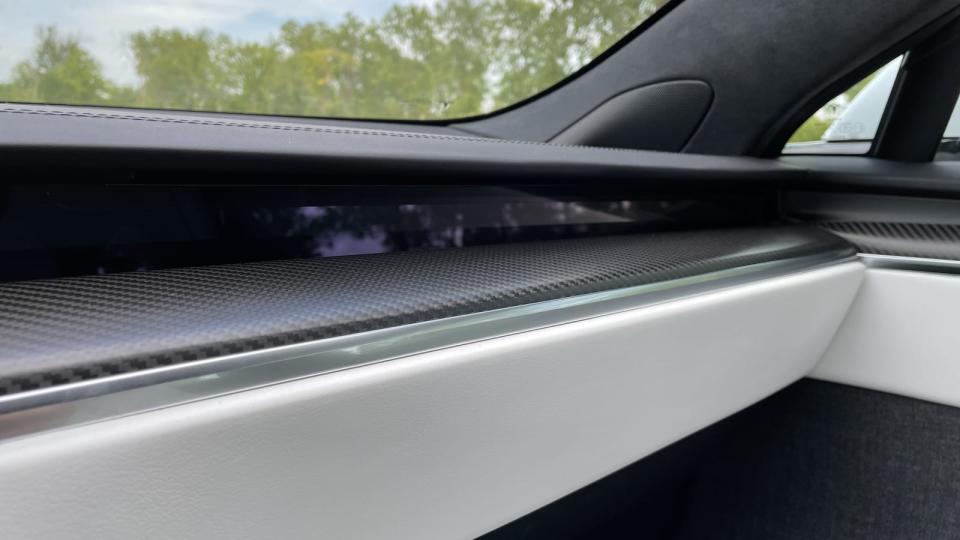
There really isn’t much to speak of throughout the Model S Plaid’s interior outside of the massive screens in front of our faces. Yes, screens. Plural. While the cheaper Model 3 and Y get one screen to rule them all, the Model S retains its digital instrument cluster. A head-up display (HUD) would be a welcome addition, but apparently you can only ask for so much with an approximately $150,000 luxury sedan. In all fairness, companies like Porsche and BMW will force you to pay extra for luxuries like a HUD, but at least they offer it.
The yoke affords an uninterrupted view of the minimalist cluster screen, but due to its width, it actually blocks your view of the bottom right corner of the infotainment system. We’ll call it a zero-sum game for yoke visibility gains and losses, as the blockage of the screen makes it such that you need to peer around the yoke to see the climate control button and the main vehicle settings menu quick toggle. Directly below the main infotainment system are a pair of wireless phone chargers that charged our phones quickly and never overheated them — take note, BMW. Really, offering two wireless phone chargers in luxury cars should be a more common feature. Your passenger might not have a cord with them 24/7.
Since this Model S is the Plaid, it gets the sporty carbon fiber trim all over the dash, doors and center console. It’s subtle, as far as carbon fiber trim goes in luxury performance cars, favoring a matte finish as opposed to the glossy carbon you’ll find all over European luxury cars. The white seats that contrast with the black trim in this Plaid were less white and more stained at this point. Again, that’s after 19,000 miles and about a year of use as a rental car. Unlike that yoke, this may be more typical for cars with white leather interiors. Either way, anybody who is thinking of ticking the box for the white interior should consider this propensity for staining before doing so.
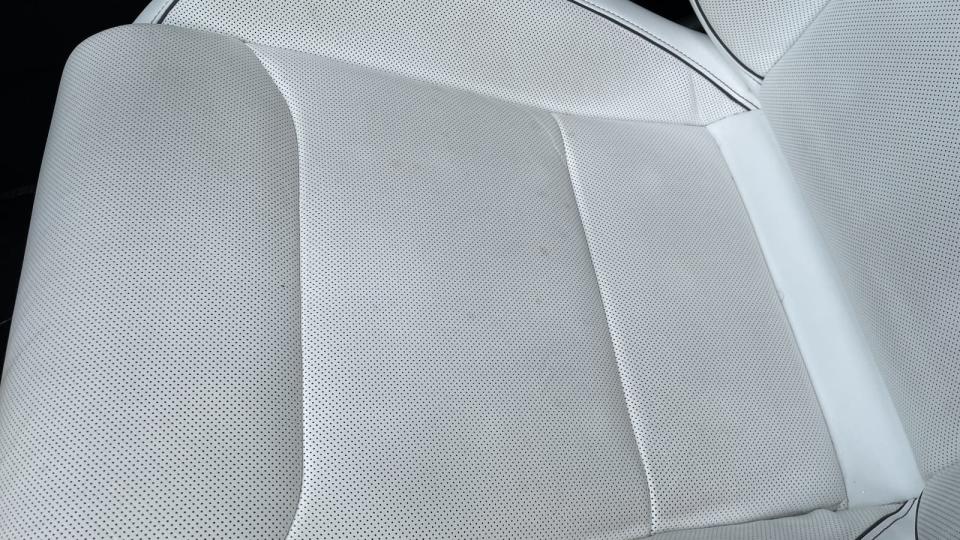
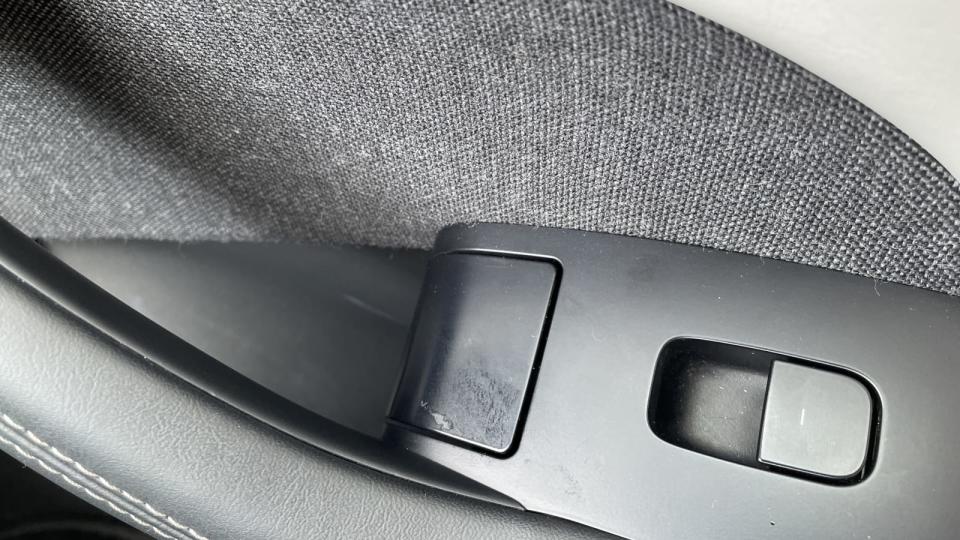
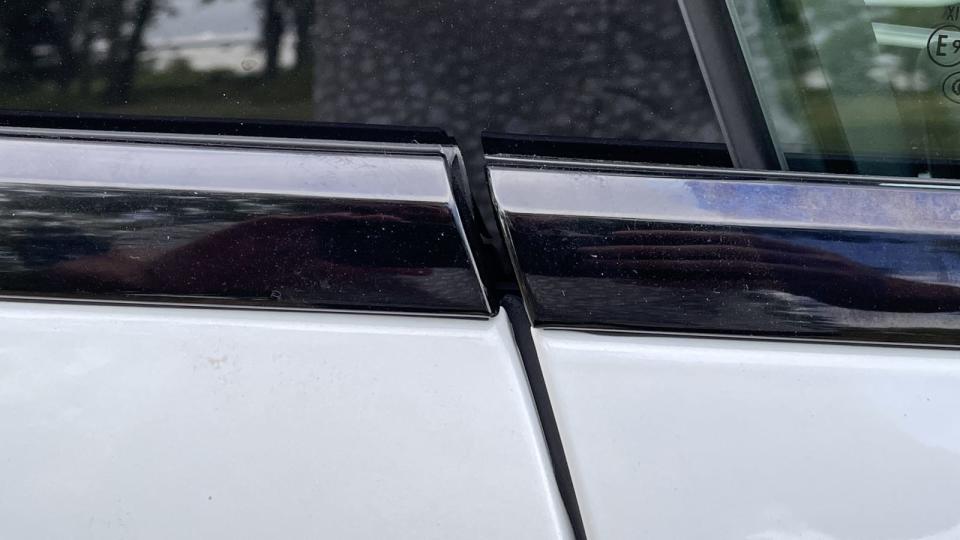
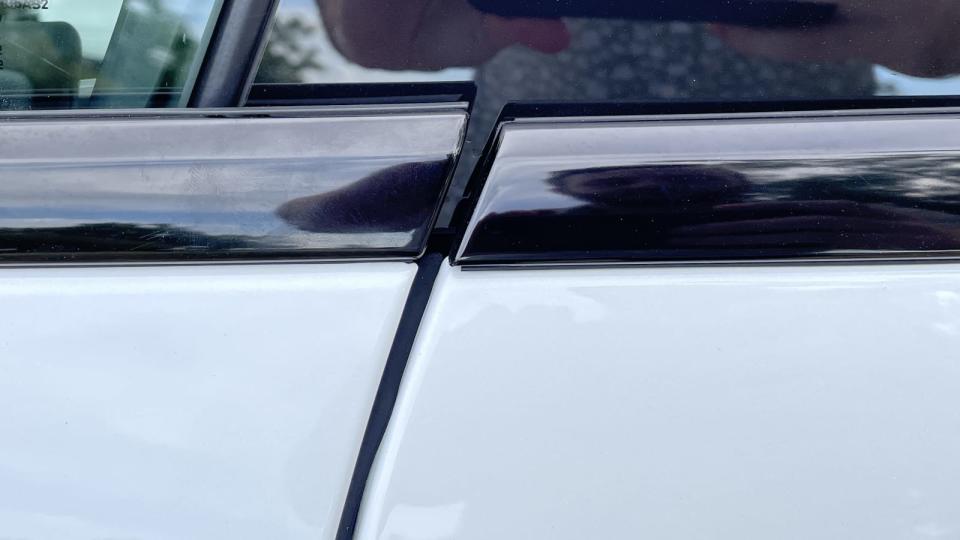
And if you were curious about other build issues, yes, the Plaid lived up (well, down) to Tesla’s reputation with mismatched panel gaps (it was particularly poor where the hatch and fender meet) and misaligned trim. The glossy black window trim was embarrassingly lopsided, and that’s something you’ll see every time you get in and out.
Your seating position is up high for a performance-oriented sport sedan, but it’s at least consistent with other EVs. The battery pack under the floor tends to push everything upward in EVs, which in turn makes visibility over the low hood excellent. We can say the same for the view out the sides, but looking through the narrow rear window is distorted. Finding a comfortable seating position requires using the touchscreen – there were regular seat-mounted controls in the original Model S interior. We can't say this is progress.
How the Plaid drives and responds to the road is largely dependent on how you set it up via the drive mode selections. Accelerating in “Chill” mode makes this tri-motor EV feel more like a Nissan Leaf from a standing start. Pop it into “Plaid” mode, and forget about hanging onto your butts, because you’ve already left them at the last stoplight by the time you realized they’re gone.

 Yahoo Autos
Yahoo Autos 